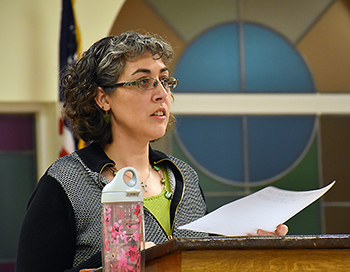| Search PNC News for stories of people and churches in our UCC Conference: |
|---|
Energy Co-op engineer explains power grid, environmental issues
Christina Carter, an electrical engineer with Big Bend Electric Cooperative, which serves Adams and Franklin counties, offered rural perspectives on the power grid in the region, state and nation.
 |
Christina Carter explains power grid, conservation issues. |
She spoke during a listening session held March 18 and 19 at Zion Philadelphia UCC in Ritzville.
Big Bend Electric has 2,500 miles of lines and serves 9,000 meters.
Many of its members are farmers and their biggest use of its energy is for irrigation.
Big Bend primarily buys hydropower from Bonneville.
Christina, a member at Zion Philadelphia and licensed engineer, said that investor-owned power companies are operated for profit of shareholders.
After she earned a degree in electrical engineering at Gonzaga University in 1997, she worked in the Tri-Cities before coming to Ritzville 10 years ago.
Puget Sound Energy and Avista serve about half of the people in the state. The rest are served by municipal public utility districts and power co-ops owned by people, she said.
“For example, Big Bend serves irrigators and small towns. Avista serves Ritzville,” she said.
Early in the 1900s, investor-owned utilities electrified the towns. In the 1930s, municipal power companies formedPublic Utility Districts (PUDs) to provide electricity to smaller communities.
In 1939, the Big Bend Electric Cooperative formed to provide power in the countryside.
There are 20 co-ops and 28 public utility districts in Washington, and just half a dozen investor-owned power companies, Christina explained.
“The public power companies and co-ops use about 82 percent hydro power, which is carbon-free power.
She said that investor owned companies have a third of their power from coal, a third from hydro and a third from a mix of gas and other sources such as wind turbines, solar, landfill gasses.
With most large dams built in the 1930s, power companies help absorb the expense of mitigation for fish, she said.
Bonneville Power Administration spends $500 million for fish mitigation, because lower dams like Bonneville have fish ladders and spillways.
Chief Joseph and Grand Coulee Dams, Christina said, have a greater drop and were not built with fish ladders or spillways.
Now Native American Tribes advocate having salmon reintroduced above those dams.
When the Columbia River Treaty is renegotiated with Canada, she said, there will be reconsideration about how much water is held above the border and and tribes want reintroduce salmon above Grand Coulee included. While toxic discharges into the Columbia in Canada from Tech Cominco have been reduced, cleanup of toxins is needed.
Power generation and spill issues affect fish. Too much spill adds oxygen in the water, which kills the fish.
Christina also explained some of the innuendos of producing, selling and trading power, and how it is complicated by antiquated transmission towers and electromagnetic relays from the 1950s
She pointed out the need to consider the mix of power sources, because power needs to be used or transmitted to California for use when it is produced. It can’t be stored, although there are efforts to build batteries to store it.
Production of solar and wind energy should to be coupled with other energy sources, she said, ideally hydro, because it’s hard to predict when and how much power solar and wind can produce, Christina said.
Solar, for example, is not as effective in Seattle as in Eastern Washington or New Mexico. Solar panels and wind turbines should to be near dams so hydro power can supplement to assure continued energy.
If there is drought, hydro power has less capacity, she said, noting that in a drought-prone area with an average rainfall of three inches, drier years are less dramatic than in areas that have 14 to 20 inches of rainfall a year.
Big Bend forecasts members’ needs in order to purchase adequate power from power suppliers.
“Irrigation pumps need constant pressure, so farmers use variable frequency drives,” she said.
“Once they are up to pressure, they use less electricity, so pumps are turned on in March and turned off in October. They run night and day. Irrigation pivots go in a one-mile circle and keep moving to keep the right amount of moisture on crops,” she said. In the desert area, crops die if they don’t have enough water, and we could be liable.”
It’s a balancing act.
Big Bend does not want to buy more power from Bonneville than farmers can use, but they have to buy enough to keep the irrigation going.
Christina said that another factor is to transmit excess power to California, after 5 p.m. when there is a surge in use. During the day, less power is needed in California, which can transmit it to Washington to keep irrigation going.
“When energy is transmitted, alternating current (AC) in converted to direct current (DC) which has less resistance and is not lost as heat as it passes through the wires,” she explained.
Once every town had its own flour mill, sawmill and bakery, and was self sufficient. Today, the power grid connects everyone.
While conservation means declining sales, the Northwest Power Council recommends conservation and energy efficiency, so Big Bend Energy Co-op promotes conservation for residential, commercial, industrial and agricultural members.
For information, call 509-347-6408 or email ccarter.ritz@gmail.com.
Copyright © April 2016 Pacific Northwest Conference News
